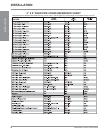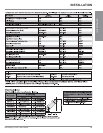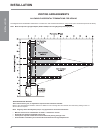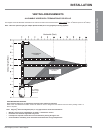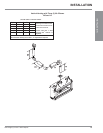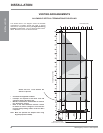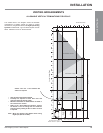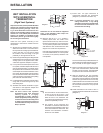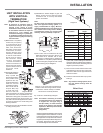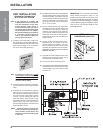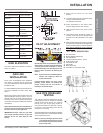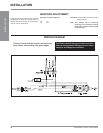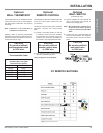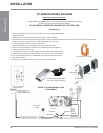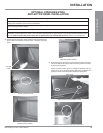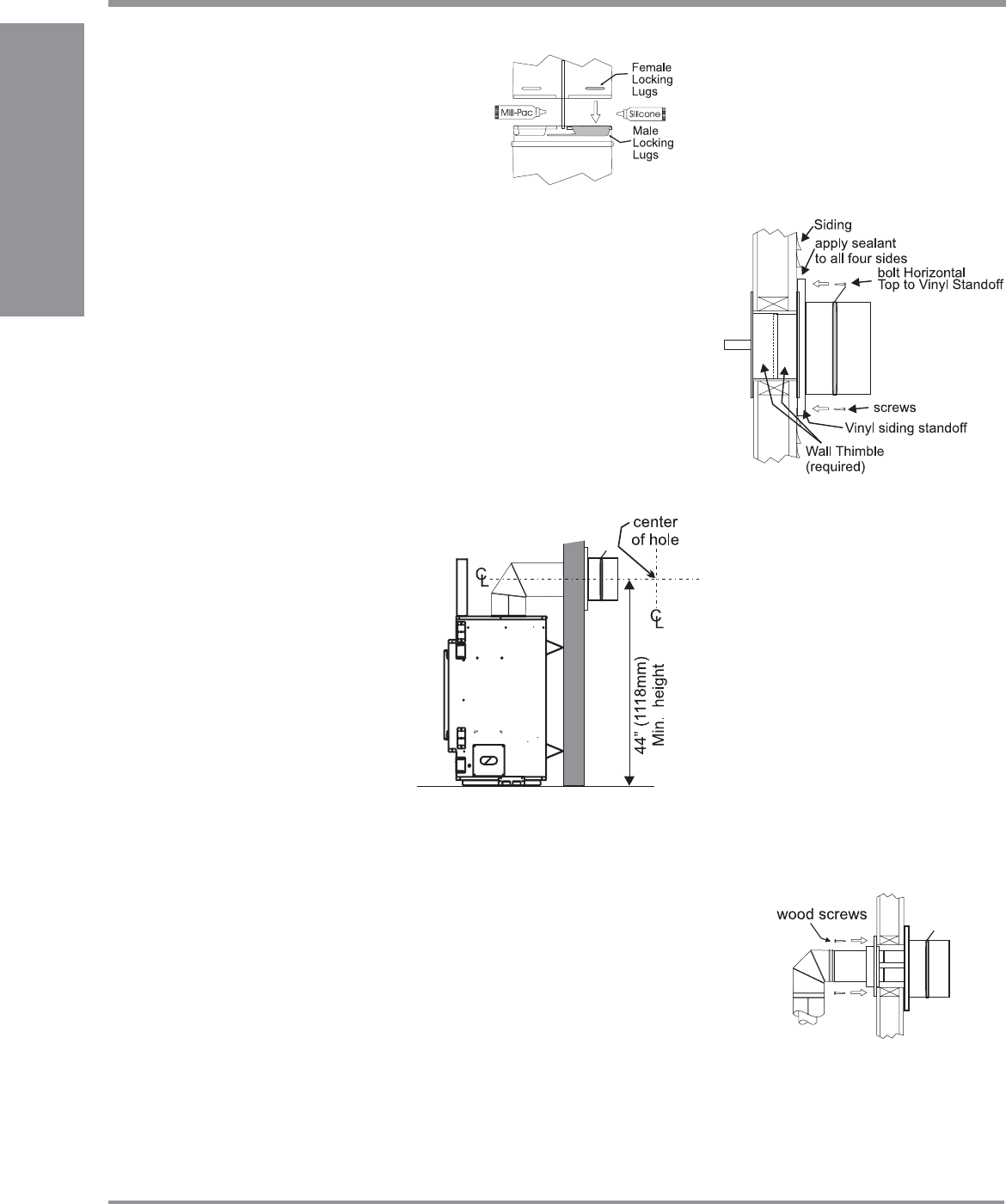
HZ54 Regency Horizon
TM
Gas Fireplace
26
INSTALLATION
INSTALLATION
Diagram 7
Diagram 5
7) Ensure that the pipe clearances to
combustible materials are maintained
(Diagram 5). Install the termination cap.
Note: If installing termination on a vinyl
siding covered wall, a vinyl siding
standoff or furring strips must be used
to ensure that the termination is not
recessed into the siding.
The four wood screws provided should be re-
placed with appropriate fasteners for stucco,
brick, concrete, or other types of sidings.
8) Before connecting the horizontal run of vent
pipe to the vent termination, slide the Wall
Thimble over the vent pipe. The wall thimble
is required for all horizontal terminations.
9) Slide the appliance and vent assembly
towards the wall carefully inserting the vent
pipe into the vent cap assembly. It is important
that the vent pipe extends into the vent cap
suffi cient distance so as to result in a minimum
pipe overlap of 1-1/4 inches (32mm). Secure
the connection between the vent pipe and
the vent cap.
10) Install wall thimble in the center of the 11"
(279mm) square and attach with wood screws
(Diagram 7).
UNIT INSTALLATION
WITH HORIZONTAL
TERMINATION
(Rigid Vent Systems)
A top clearance of 3"(76mm) and side & bottom
clearance of 2"(51mm) must be maintained;
except when passing through a wall, ceil-
ing, or at the termination where the use of a
fi restop or wall thimble reduces the required
clearance to 1-1/2" (38mm). We recommend
framing a 11"(279mm) x 11"(279mm) (inside
dimensions) hole to give structural rigidity
for mounting the termination.
Install the vent system according to the
manufacturer's instructions included with the
components.
1) Set the unit in its desired location. Check to
determine if wall studs or roof rafters are in
the way when the venting system is attached.
If this is the case, you may want to adjust
the location of the unit. Rough in the gas
preferably on the right side of the unit.
2) Direct Vent pipe and fi ttings are designed with
special twist-lock connections to connect the
venting system to the appliance fl ue outlet.
A twist-lock appliance adaptor is required.
3) In conjunction with the Simpson Direct Vent
Pro system, install the adaptor after the unit is
set in its desired location. Put a bead of high
temperature silicone inside the outer section
of the adapter and a bead of Mill Pack on the
inner collar. Slip the adapter over the existing
inner and outer fl ue collar. Fasten to the outer
collar only with the 3 supplied screws (drilling
pilot holes will make this easier).
4) Level the fi replace and fasten it to the framing
using nails or screws through the top and
side nailing strips.
5) Assemble the desired combination of pipe
and elbows to the appliance adaptor and
twist-lock for a solid connection.
Note: For best results and optimum
performance with each approved
venting system, it is highly
recommended to apply “Mill-Pac”
sealant (supplied) to every inner pipe
connection. Failure to do so may result
in drafting or performance issues not
covered under warranty. Silicone (red
RTV) is optional.
Diagram 1
6) Mark the wall for a 11" x 11" (279mm x
279mm) square hole. The center of the
square hole should line up with the center-
line of the horizontal pipe. Cut and frame the
11 inch (279mm) square hole in the exterior
wall where the vent will be terminated. See
diagram 2 for center line requirements.
If the wall being penetrated is constructed of
non-combustible material, i.e. masonry block
or concrete, an 8" (203mm) diameter hole
is acceptable.
Diagram 2
Note:
a) The horizontal run of vent must be level,
or have a 1/4 inch rise for every 1 foot
of run towards the termination. Never
allow the vent to run downward. This
could cause high temperatures and may
present the possibility of a fi re.
b) The location of the horizontal vent
termination on an exterior wall must meet
all local and national building codes, and
must not be blocked or obstructed. See
"Exterior Vent Termination Locations"
section for more details.
Horizontal runs of vent must be supported
every 3 feet (0.9meter). Wall straps are
available for this purpose.



